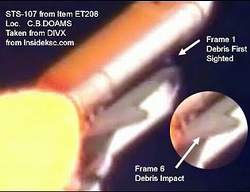Fri, Aug 01, 2003
CAIB Wants Pictures Can Help Troubleshoot Potential Debris
Issues
 NASA needs to see the
big picture when it comes to any future shuttle launches. That's
the recommendation of the Columbia Accident Investigation Board
(CAIB), which says high-resolution photos of the tank taken during
lift-off could help avoid another debris-related disaster. Columbia
disintegrated February 1st as it re-entered the atmosphere at the
end of a two-week long mission.
NASA needs to see the
big picture when it comes to any future shuttle launches. That's
the recommendation of the Columbia Accident Investigation Board
(CAIB), which says high-resolution photos of the tank taken during
lift-off could help avoid another debris-related disaster. Columbia
disintegrated February 1st as it re-entered the atmosphere at the
end of a two-week long mission.
The CAIB, charged with reporting to lawmakers and the American
people on how that could happen, says debris shed from the external
fuel tank probably punched a hole in the orbiter's left wing. That,
they theorize, allowed super-hot gases to melt critical parts of
the shuttle, eventually leading to its destruction. All seven
astronauts on board were killed.
"Imaging the space shuttle system during launch and ascent
provides necessary engineering data including the ability to
examine the space shuttle system for any unexpected debris or other
anomalies during ascent," the board said on its web site, www.caib.us.
All three remaining shuttles have cameras on board capable of
imaging the external fuel tank. The problem is, those pictures can
only be downloaded after the shuttle's mission is complete. One of
the board's recommendations, expected to be finalized by the end of
the month, will be for NASA to concoct a way to beam those pictures
back while the shuttle is still in orbit. That way, if there's any
sign of debris flaking off the external tank, engineers can figure
out what sort of damage it caused and how that damage should be
addressed.

The recommendations released Wednesday mark the fifth time the
CAIB has spoken out on its ideas for making shuttle flights safer.
The board also suggests the International Space Station be used as
an emergency repair facility should the space planes find
themselves in orbit, unable to land.
But that wouldn't have helped Columbia. As the first shuttle put
into service, it was simply too heavy to make the trip 240 miles
into space for a rendezvous with the ISS. In fact, the CAIB
has yet to say what, if anything, might have saved STS-107.
More News
He Attempted To Restart The Engine Three Times. On The Third Restart Attempt, He Noticed That Flames Were Coming Out From The Right Wing Near The Fuel Cap Analysis: The pilot repor>[...]
Make Sure You NEVER Miss A New Story From Aero-News Network Do you ever feel like you never see posts from a certain person or page on Facebook or Instagram? Here’s how you c>[...]
From 2009 (YouTube Edition): Leading Air Show Performers Give Their Best Advice for Newcomers On December 6th through December 9th, the Paris Las Vegas Hotel hosted over 1,500 air >[...]
Aero Linx: NASA ASRS ASRS captures confidential reports, analyzes the resulting aviation safety data, and disseminates vital information to the aviation community. The ASRS is an i>[...]
“For our inaugural Pylon Racing Seminar in Roswell, we were thrilled to certify 60 pilots across our six closed-course pylon race classes. Not only did this year’s PRS >[...]
 NTSB Final Report: Rutan Long-EZ
NTSB Final Report: Rutan Long-EZ ANN FAQ: Turn On Post Notifications
ANN FAQ: Turn On Post Notifications Classic Aero-TV: ICAS Perspectives - Advice for New Air Show Performers
Classic Aero-TV: ICAS Perspectives - Advice for New Air Show Performers ANN's Daily Aero-Linx (06.28.25)
ANN's Daily Aero-Linx (06.28.25) Aero-News: Quote of the Day (06.28.25)
Aero-News: Quote of the Day (06.28.25)




